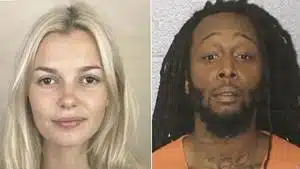News from the South - Arkansas News Feed
Federal cuts squeeze already-struggling food banks, school lunch programs
by Kevin Hardy, Stateline, Arkansas Advocate
March 27, 2025
For the Day Eagle Hope Project, federal money has helped volunteers deliver fresh produce and meat to families in need across the remote Fort Belknap Indian Reservation in northern Montana — while putting cash into the hands of farmers, ranchers and meat processors.
The nonprofit generally has less than $300,000 to spend per year. So the $200,000 from a U.S. Department of Agriculture local food buying program significantly raised both the quantity and quality of the food it could distribute.
“They were a major, major contributor to our food,” said Tescha Hawley, who directs the organization, which aims to improve physical, mental and spiritual health.
The USDA recently nixed more than $1 billion from two programs that helped food banks and school meal programs buy local foods, including $660 million for schoolchildren. U.S. Agriculture Secretary Brooke Rollins recently described the programs as “nonessential.”
But the move has left hundreds of school systems and food banks reeling. They already face rising food prices and are struggling to help community members with growing food insecurity.
Created in response to the COVID-19 pandemic, the Local Food Purchase Assistance and the Local Food for Schools programs aimed to build more resilient supply chains of domestic food by connecting schools and food pantries with small ranches, farms and dairies. The program was initially funded by 2021’s American Rescue Plan Act but later expanded by the Biden administration.
The federal programs stimulated the purchase of locally grown fruits, vegetables, dairy and meats — benefiting both the smaller farmers who received fair market pay for their products and the organizations granted funds to buy high quality foods.
The noncompetitive grants sent hundreds of millions of dollars to all 50 states, the District of Columbia and 84 tribal governments, boosting business for more than 8,000 farmers and providing local food to almost as many food banks. The Trump administration is killing the programs, despite Health and Human Services Secretary Robert F. Kennedy Jr.’s campaign against processed food, which he says is “poisoning” Americans.
Without ongoing funding, Hawley said, she would have to rely on cheaper, less nutritious food.
“It’s simple, right? I can get a truck … in here with all highly processed food, no problem,” she said.
Schools are facing a similar challenge: While officials running breakfast and lunch programs would prefer to buy more local products, those are often expensive. And with underfunding, high food costs and labor struggles, school lunch programs are already stretched thin.
In Milan, Tennessee, the federal funds allowed the local school system to buy minimally processed beef from a local stockyard, and broccoli, purple hull peas, tomatoes and melons from local growers.
Vickie Dunaway, who supervises the school system’s food services, told the Tennessee Lookout the federal cuts mean “going backwards” on purchasing healthier foods.
“That will obviously have to be cut out, because our budget will not withstand being able to purchase local,” she said. “Purchasing local, minimally processed food is way more expensive than buying from a distributor.”
A ‘devastating’ cut to food banks
Late last year, USDA said the programs had already spent more than $1 billion on local foods, and announced an expansion of the two programs with an additional $1.13 billion. USDA has killed that $1.13 billion expansion; it is still reimbursing the previously committed funds.
The Trump administration, which has sought to dramatically slash the size of the federal government, told recipients earlier this month that the programs “no longer effectuate the goals of the agency.”
In a statement to Stateline, the USDA said the current administration is “prioritizing stable, proven solutions that deliver lasting impact.”
“The COVID era is over — USDA’s approach to nutrition programs will reflect that reality moving forward,” the statement said.
The only thing we’ll be able to do is just ration what little we have — to spread it as thinly as possible over the number of households we provide food to.
– Eric Cooper, president and CEO, San Antonio Food Bank
The nonpartisan National Association of State Departments of Agriculture, which represents the ag department leaders of all 50 states, last month lobbied the federal government to continue the local foods program with permanent funding and ease procurement regulations for school meal programs. Arkansas Secretary of Agriculture Wes Ward, president of the association, said in a statement that the local food programs aid both producers and consumers.
“Investing in local and regional food systems not only strengthens the connections between farmers and their local communities, it bolsters supply chain resiliency as well,” his statement read.
In New Mexico, the program allowed food banks to buy some 900,000 pounds of locally grown food from more than 200 farmers since 2023. Before the program was terminated, the state was expecting close to $3 million in additional funding, Source New Mexico reported.
Jill Dixon, executive director of The Food Depot in northern New Mexico, called the cuts “devastating.”
In Texas, the San Antonio Food Bank counted on USDA’s local food program to help round out the food boxes it provides to families in need. The food bank, which serves more than 100,000 people across 29 Texas counties, largely relies on donated foods from hotels, restaurants and grocery stores.
“The challenge is I might get peanut butter donated, but I don’t have the jelly, or I might have pasta donated, but I don’t have the marinara,” said Eric Cooper, president and CEO of the food bank. “This program allowed us to purchase those items that we didn’t get that then helped round out the food box, or really complement the food that was being donated to give families the ability to make meals.”
The program initially provided the food bank nearly $3 million in grant funding — about 20% of what the organization spends each year on bulk food purchases. It expected a similar amount this year, before USDA’s announcement.
Cooper said cuts come even as the need for assistance rises. Food prices have squeezed families, and mass layoffs of federal workers portend more demand for food assistance in the coming months, he said.
“And we’ll be caught in the middle. And you know, that’s an incredibly uncomfortable place to be. The only thing we’ll be able to do is just ration what little we have — to spread it as thinly as possible over the number of households we provide food to.”
A boost for school lunches
For years, school meal programs have struggled with tight margins. Not only do they have to meet strict nutritional guidelines, but schools also face lagging reimbursement from the federal government and spend millions covering the cost of students’ unpaid meal debt.
At the 1,600-student Monticello School District in Arkansas, that debt is approaching $60,000.
So $50,000 from USDA’s local food program was a significant boost to the bottom line.
“That was such a help,” said Amanda West, the district’s child nutrition director.
The southeast Arkansas district used grant money to buy locally grown ground beef. The beef went into dishes including taco salad, meatloaf and spaghetti.
West said staff and students immediately noticed a difference in taste from conventionally purchased meats. And though the local product cost more, West said it also yielded more because it was not full of additives that cause the meat to shrink when cooked.
West, who is the president of the Arkansas School Nutrition Association, noted that her state is home to the nation’s highest rates of food insecurity.
West had hoped to see the local foods program help turn that tide by bringing more stability to school meal programs and growing the state economy by boosting local farmers, ranchers and distributors.
“We’re all upset about it. I hate that we’re not receiving it because grocery prices are 30, 40% higher than what they were a few years ago, and it really hurts our budget,” she said. “It helped a lot of districts, including mine, and it would be amazing if we could get it back.”
On top of the local foods program cuts, congressional Republicans are considering billions in potential cuts to free and reduced-price school meal programs — cuts the School Nutrition Association says could potentially affect millions of American students.
The federal government partially subsidizes breakfast, lunch and after-school snack programs at rates calculated by the income level of students’ families.
The School Nutrition Association, which represents 50,000 school meal providers across the country, said the school meals are the healthiest many American children receive. But that group says federal reimbursements are far from adequate, leaving members worried about the future of their meal programs.
In a recent association survey of more than 1,390 school meal directors, more than 90% reported serious or moderate concern over the financial sustainability of their school meal programs three years from now.
Stateline reporter Kevin Hardy can be reached at khardy@stateline.org.
Stateline is part of States Newsroom, a nonprofit news network supported by grants and a coalition of donors as a 501c(3) public charity. Stateline maintains editorial independence. Contact Editor Scott S. Greenberger for questions: info@stateline.org.
Arkansas Advocate is part of States Newsroom, a nonprofit news network supported by grants and a coalition of donors as a 501c(3) public charity. Arkansas Advocate maintains editorial independence. Contact Editor Sonny Albarado for questions: info@arkansasadvocate.com.
The post Federal cuts squeeze already-struggling food banks, school lunch programs appeared first on arkansasadvocate.com
News from the South - Arkansas News Feed
NW Arkansas Championship expected to bring money to Rogers
SUMMARY: The Northwest Arkansas Championship in Rogers is more than a golf event; it significantly boosts the local economy. Drawing thousands annually, it brings steady crowds benefiting restaurants, shops, and service providers. Businesses report increased sales, especially in food and hydration products, with parking lots near the course filling quickly. The Rogers Chamber estimates the tournament injects around $14 million into the local economy, supporting small businesses. Starting tomorrow with a 5K event at the LPGA, this week-long tournament is a dependable source of customer traffic and highlights Rogers’ growth as a regional hub.
Rogers businesses make money off the LPGA’s NW Arkansas Championship.
40/29 is your home for Northwest Arkansas and the River Valley breaking news and weather. For your latest Northwest Arkansas and the River Valley news and weather visit: https://www.4029tv.com/
For licensing inquiries: https://www.4029tv.com/licensing
News from the South - Arkansas News Feed
Arkansas medical marijuana sales on pace for record year
SUMMARY: Arkansas medical marijuana sales are on track for a record year, with patients spending over $193 million from January to August 2025—more than $10 million higher than last year. The state currently has 109,000 active patient cards, purchasing over 52,000 pounds of cannabis products. Daily sales average around $800,000, generating more than $21 million in taxes this year. A new law directs part of this tax revenue to combat food insecurity, including eliminating school lunch debt statewide. Since 2019, Arkansas patients have spent over $1.5 billion on medical marijuana, with the state collecting more than $105 million in taxes.
Arkansas medical marijuana sales on pace for record year 40/29 is your home for Northwest Arkansas and the River Valley …
News from the South - Arkansas News Feed
Group in lawsuit say Franklin county prison land was bought before it was inspected
SUMMARY: A group filed a complaint against the Franklin County Prison project, claiming the land was purchased before proper inspection, resulting in unsuitable property acquisition and wasted taxpayer money. A study cited by State Senator Brian King revealed the site cannot supply adequate water for even one home, let alone a 3,000-bed prison. Despite ongoing prison overcrowding and the need for a new facility, concerns remain about the project’s viability. Lawmakers discussed the issue, highlighting overcrowding and early release of violent offenders due to lack of space. The Franklin County Prison project aims to build a 3,000-bed facility, but its future is uncertain amid these challenges.
Group in lawsuit say Franklin county prison land was bought before it was inspected
40/29 is your home for Northwest Arkansas and the River Valley breaking news and weather. For your latest Northwest Arkansas and the River Valley news and weather visit: https://www.4029tv.com/
For licensing inquiries: https://www.4029tv.com/licensing
-
News from the South - North Carolina News Feed6 days ago
What we know about Charlie Kirk shooting suspect, how he was caught
-
Local News7 days ago
Russian drone incursion in Poland prompts NATO leaders to take stock of bigger threats
-
News from the South - North Carolina News Feed6 days ago
Federal hate crime charge sought in Charlotte stabbing | North Carolina
-
Local News Video7 days ago
Introducing our WXXV Student Athlete of the Week, St. Patrick’s Parker Talley!
-
The Center Square7 days ago
Weapon recovered as manhunt continues in Kirk assassination investigation | National
-
Our Mississippi Home5 days ago
Screech Owls – Small but Cute
-
News from the South - Arkansas News Feed6 days ago
NW Arkansas Championship expected to bring money to Rogers
-
News from the South - Alabama News Feed7 days ago
News 5 NOW at 8:00am | September 11, 2025















































